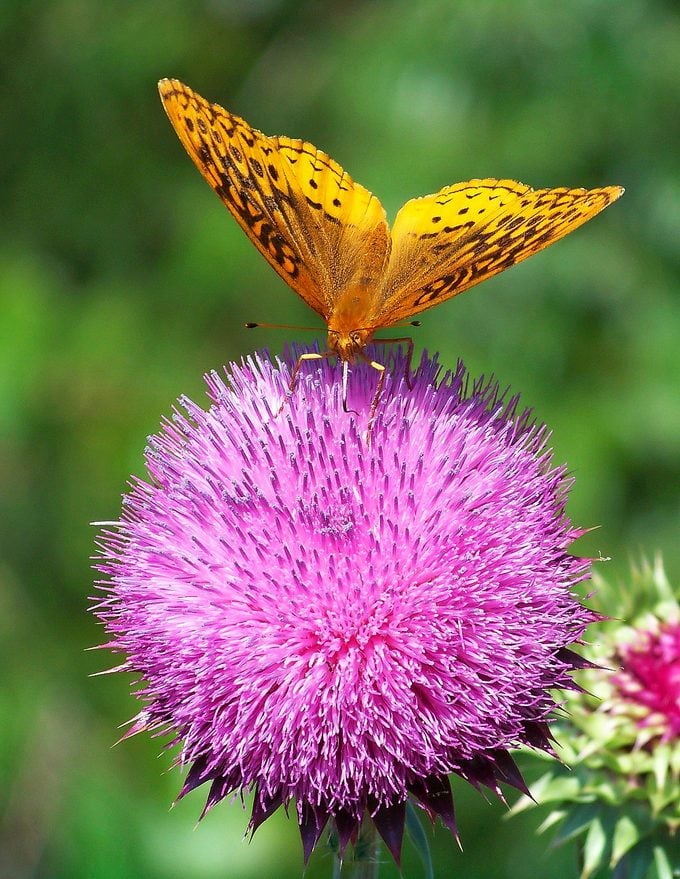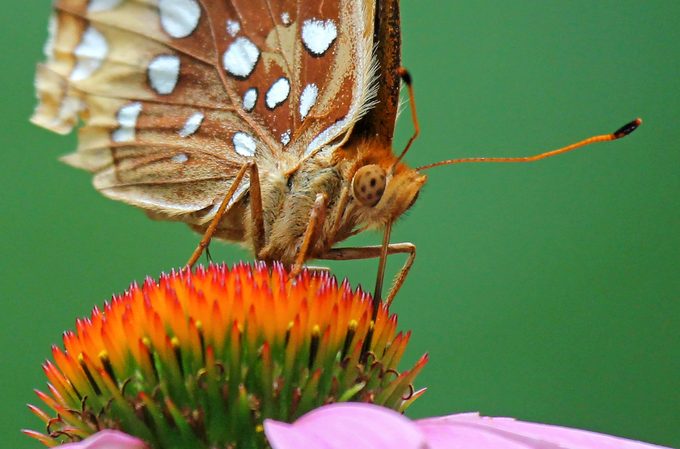Meet the Gorgeous Great Spangled Fritillary Butterfly
Updated: May 22, 2024
Learn to identify a great spangled fritillary. Look for glints of silver on large orange wings to identify these butterflies that flit through gardens in summertime.
On This Page
Great Spangled Fritillary Butterfly Identification

- Distinctive Markings: Rust-colored with black checker-like pattern and silvery spots on the underside of the hindwing. The female is slightly darker than the male.
- Wingspan: 2 1/2 to 4 inches
- Habitat: Open, moist areas such as meadows, prairies and edges of woodlands
- Host Plant: Females lay their eggs near violets, the only plants caterpillars eat.
- Backyard Favorites: Adults sip nectar from common milkweed, Joe Pye weed, verbena and red clover.
- Life Cycle: Great spangled caterpillars hatch in the fall, overwinter in that stage, and then finally take their first bites of food in spring.
- Name Meaning: Fritillary comes from the Latin word fritillus, which means dice box or checkerboard.

When most people see a flash of orange from a passing butterfly, they automatically assume it’s a monarch. There are plenty of other orange butterflies, though, many the same size and flying in the same range. Once you take a closer look, most of them don’t really resemble a monarch. One good example is the great spangled fritillary (Speyeria cybele), a gorgeous orange and brown butterfly that can be seen coast to coast across the northern half of the U.S. and into southern Canada.
Attract Gulf fritillary butterflies with their favorite plants.
Similar Butterfly Species

Great spangled fritillaries resemble several other butterfly species in their range, including the Aphrodite fritillary (Speyeria aphrodite) and the Atlantis fritillary (Speyeria atlantis).
If you’re interested in the specific details of telling them apart, try visiting the Massachusetts Butterfly Club for side-by-side comparison pages.
Great Spangled Fritillary Caterpillar

The caterpillar has a black body with black spikes protruding from rows of reddish orange bases. Its head is also black with some areas of orange or red. Great spangled fritillary eggs are a flattened cone shape in a creamy white that turns to a golden tan.
Watch Your flowers for a Diana fritillary butterfly.
Great Spangled Fritillary Life Cycle

These butterflies have only one generation each year, with adults emerging in early summer. They have a fairly long lifespan, too. Most butterflies are in flight for about a month at most, and many for much less.
Great spangled fritillaries, on the other hand, will fly from mid-June to mid-September. They mate in midsummer, and females lay their eggs on or near native violet species.
The eggs hatch not long after they’re laid, but the minuscule caterpillars don’t start eating. Instead, they burrow down into the earth to find a safe hiding place and enter diapause (insect hibernation, basically) until spring.
When the weather warms up, they emerge and begin feeding on the new foliage of the native violets. They eat for a few weeks, spend a few weeks in chrysalis, and then emerge around the time summer kicks in to start the process all over again.
How to Attract Great Spangled Fritillaries

Great spangled fritillaries will visit many nectar flowers during their flight time, so any butterfly gardener in their range stands a good chance of seeing them in their own garden. To up your odds, try planting some native violet species for them to lay their eggs on.
“One of my flower gardens is designed to attract hummingbirds and butterflies. Last year, great spangled fritillaries were exceptionally numerous and visited purple coneflowers the most,” says Birds & Blooms reader Elisa Shaw of Red Hook, New York.
Sources
- U.S. Department of Agriculture – Fritillary: A Pretty Butterfly and a Good Pollinator
- Massachusetts Butterfly Club
Why Trust Us
For nearly 30 years, Birds & Blooms, a Trusted Media Brand, has been inspiring readers to have a lifelong love of birding, gardening and nature. We are the #1 bird and garden magazine in North America and a trusted online resource for over 15 million outdoor enthusiasts annually. Our library of thousands of informative articles and how-tos has been written by trusted journalists and fact-checked by bird and garden experts for accuracy. In addition to our staff of experienced gardeners and bird-watchers, we hire individuals who have years of education and hands-on experience with birding, bird feeding, gardening, butterflies, bugs and more. Learn more about Birds & Blooms, our field editor program, and our submission guidelines.






















